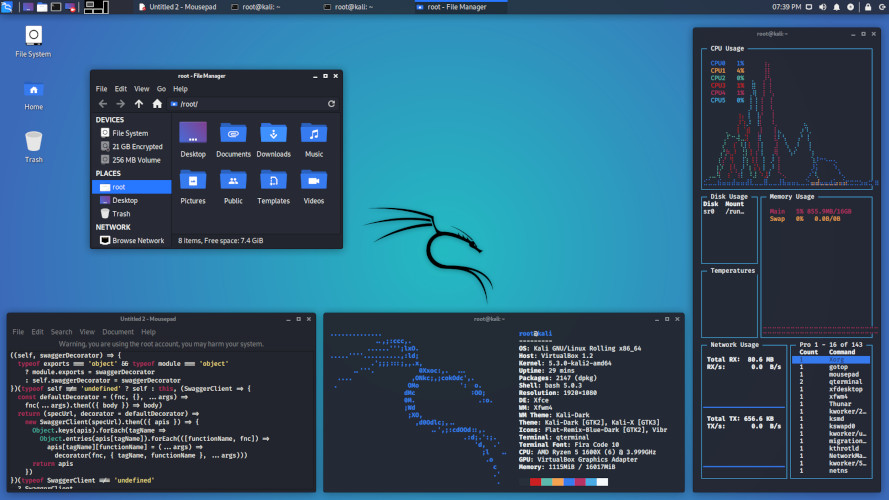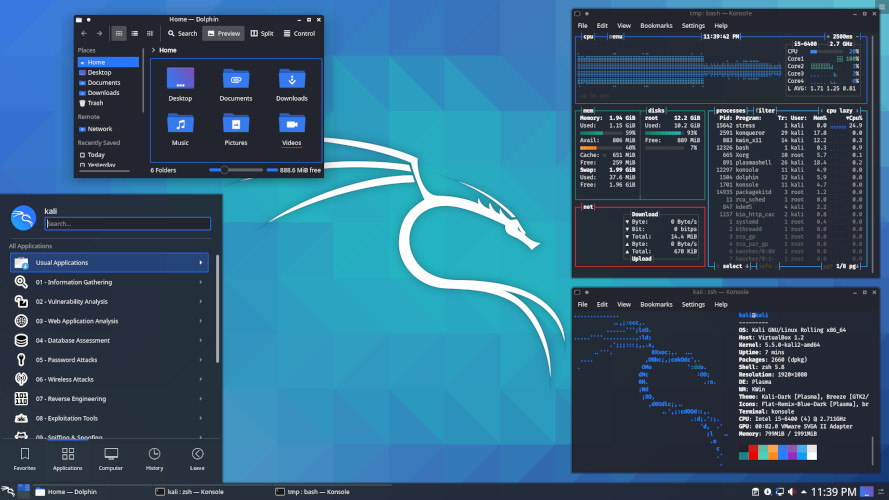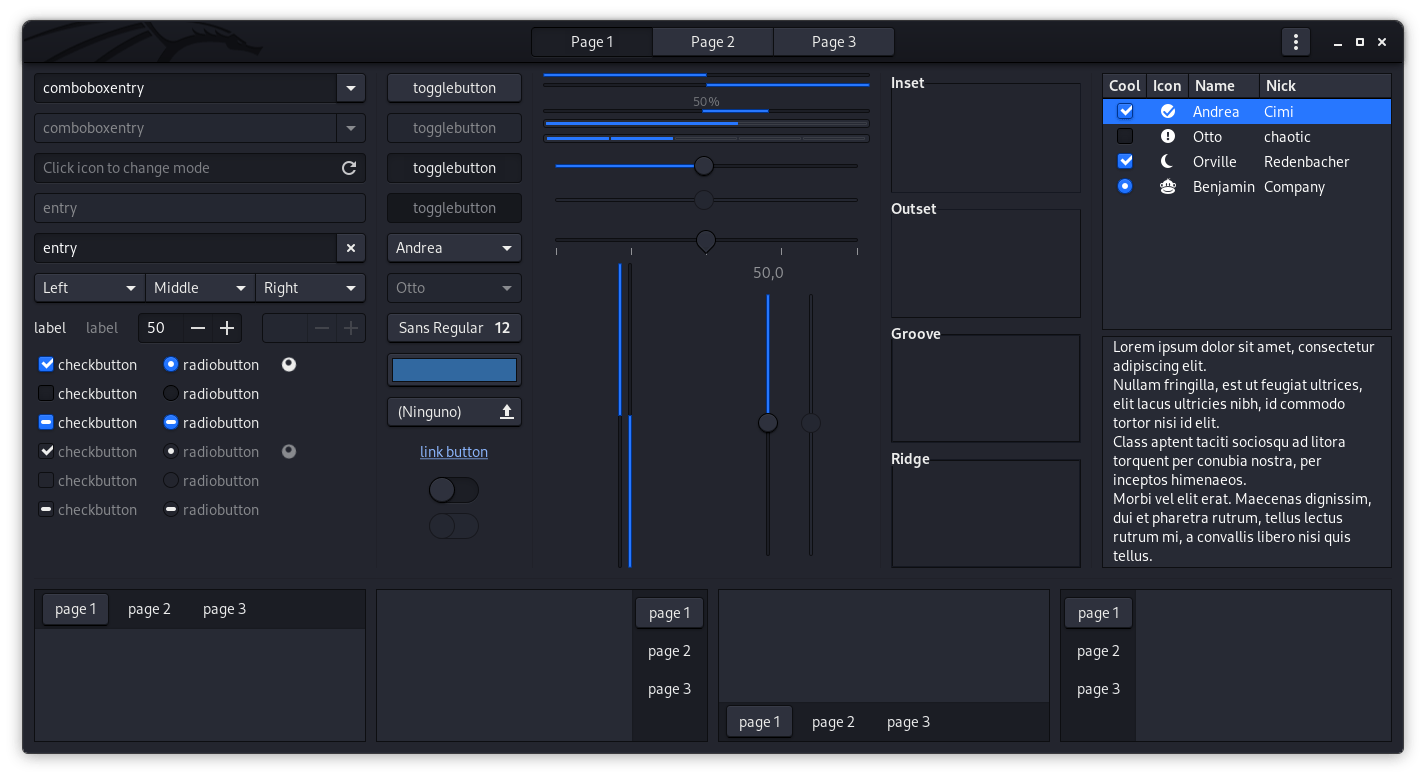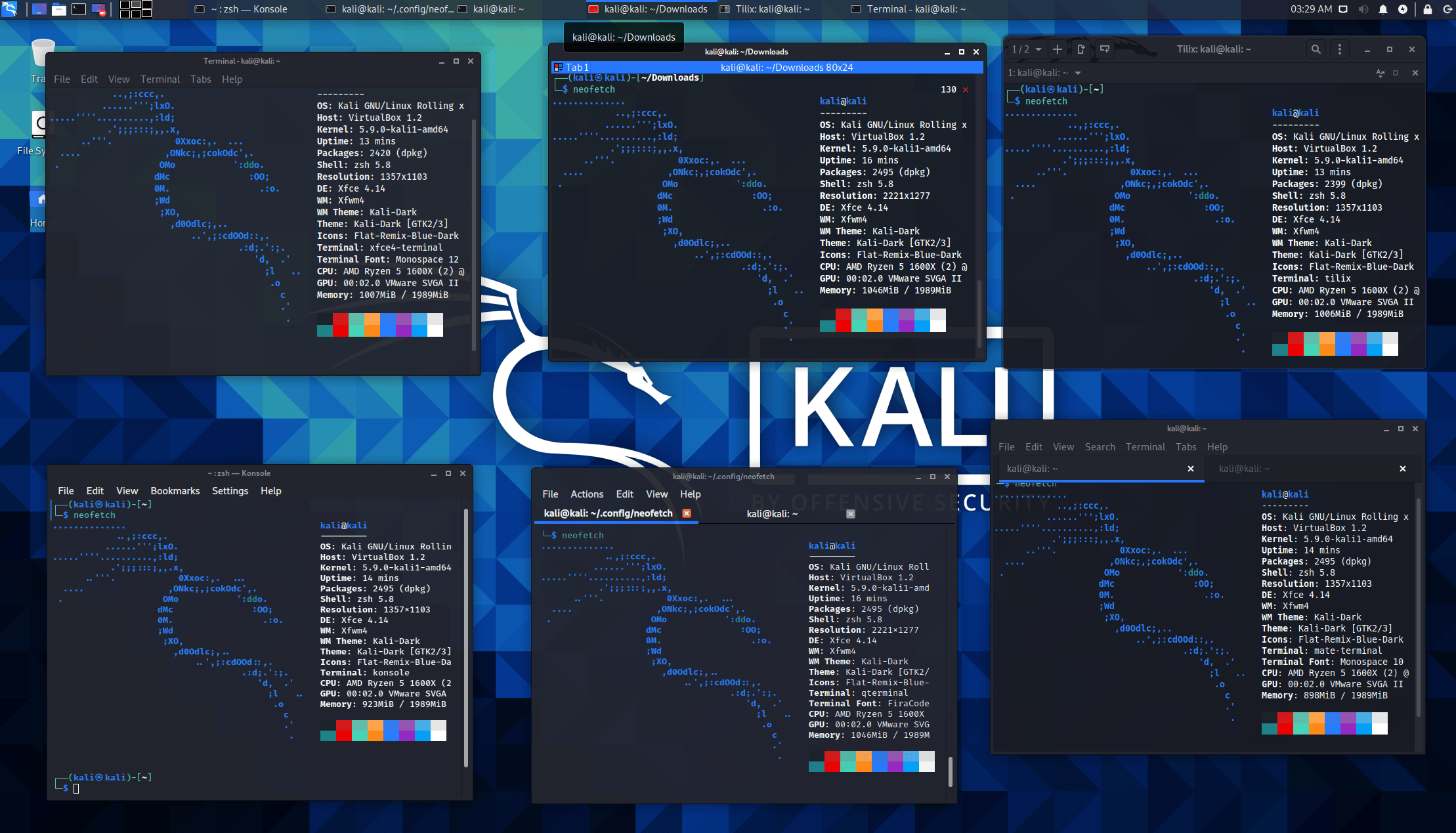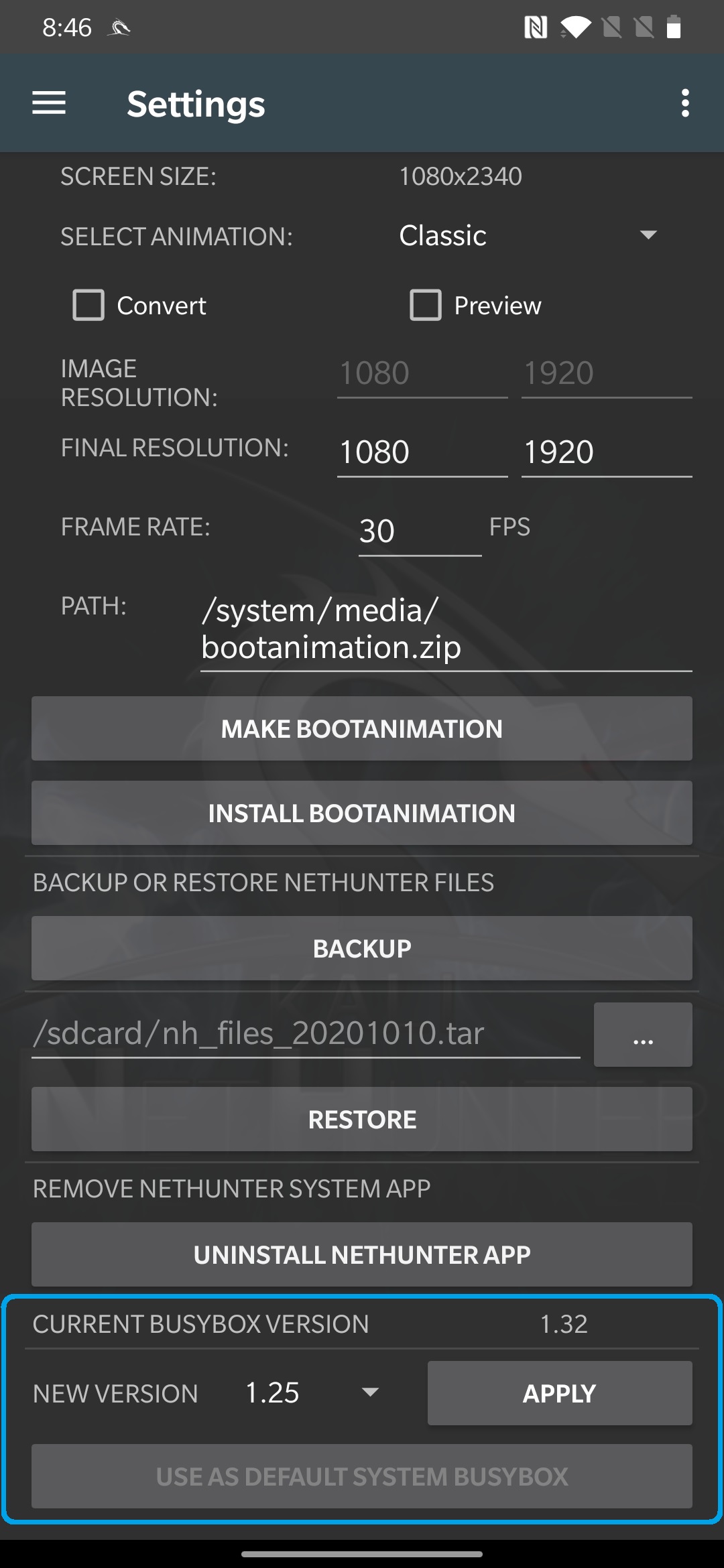Kali Linux
The most advanced Penetration Testing Distribution. Ever.
The most advanced
Penetration Testing Distribution
Kali Linux is an open-source, Debian-based Linux distribution geared towards various information security tasks, such as Penetration Testing, Security Research, Computer Forensics and Reverse Engineering.
The Industry Standard
Kali Linux is not about its tools, nor the operating system. Kali Linux is a platform.
You can take any Linux and install pentesting tools on it, but you have to set the tools up manually and configure them. Kali is optimized to reduce the amount of work, so a professional can just sit down and go.
A version of Kali is always close to you, no matter where you need it. Mobile devices, Docker, ARM, Amazon Web Services, Windows Subsystem for Linux, Virtual Machine, bare metal, and others are all available.
With the use of metapackages, optimized for the specific tasks of a security professional, and a highly accessible and well documented ISO customization process, it’s always easy to generate an optimized version of Kali for your specific needs.
Whether you are a seasoned veteran or a novice, our documentation will have all the information you will need to know about Kali Linux. Multiple tips and “recipes” are available, to help ease doubts or address any issues. All documentation is open, so you can easily contribute.
Kali Linux, with its BackTrack lineage, has a vibrant and active community. There are active Kali forums, IRC Channel, Kali Tools listings, an open bug tracker system, and even community provided tool suggestions.
All the tools you need
The Kali Linux penetration testing platform contains a vast array of tools and utilities. From information gathering to final reporting, Kali Linux enables security and IT professionals to assess the security of their systems.
Find out all about Kali’s Tools
Kali Everywhere
Undercover Mode
Using Kali in an environment where you don’t want to draw attention to yourself? Kali Undercover is the perfect way to not stand out in a crowd.
Kali NetHunter
A mobile penetration testing platform for Android devices, based on Kali Linux. Kali NetHunter is made up of an App, App Store, Kali Container and KeX
Win-KeX
Win-KeX provides a full Kali Desktop Experience for Windows WSL. Applications started via Kali’s panel will share the desktop with Microsoft Windows applications.
Bare Metal
Cloud
Containers
Mobile
Virtual Machines
Choose the desktop you prefer
Xfce
Xfce is a lightweight desktop environment for UNIX-like operating systems. It aims to be fast and low on system resources, while still being visually appealing and user friendly.
Xfce consists of separately packaged parts that together provide all functions of the desktop environment, but can be selected in subsets to suit user needs and preferences. This is Kali’s default desktop environment.
GNOME Shell
Every part of GNOME 3 has been designed to make it simple and easy to use. The Activities Overview is an easy way to access all your basic tasks. A press of a button is all it takes to view your open windows, launch applications, or check if you have new messages. Having everything in one place is convenient and means that you don’t have to learn your way through a maze of different technologies.
KDE Plasma
Plasma is made to stay out of the way as it helps you get things done. But under its light and intuitive surface, it’s a powerhouse. So you’re free to choose ways of usage right as you need them and when you need them.
With Plasma the user is king. Not happy with the color scheme? Change it! Want to have your panel on the left edge of the screen? Move it! Don’t like the font? Use a different one! Download custom widgets in one click and add them to your desktop or panel.
Latest news from our blog
Kali Linux 2021.3 Release (OpenSSL, Kali-Tools, Kali Live VM Support, Kali NetHunter Smartwatch)
Kali Linux 2021.2 Release (Kaboxer, Kali-Tweaks, Bleeding-Edge & Privileged Ports)
Say hello to Kali Linux 2021.2! This release welcomes a mixture of new items as well as enhancements of existing features, and is ready to be downloaded (from our updated page) or upgraded if you have an existing Kali Linux installation. A quick summary of the changelog since the 2021.1 release from February 2021 is:
Ampere Hardware & Kali Linux
When Ampere partnered with Debian, this caught our eye. We were aware that our current ARM cloud provider was soon ending support for arm64 servers (which we use for our build daemons). At Kali Linux, one of the things which is important to us, is that we prefer not having to cross-compile our ARM binaries that we ship in our Kali packages.
Kali Linux Blog
Say hello to Kali Linux 2021.2! This release welcomes a mixture of new items as well as enhancements of existing features, and is ready to be downloaded (from our updated page) or upgraded if you have an existing Kali Linux installation. A quick summary of the changelog since the 2021.1 release from February 2021 is:
When Ampere partnered with Debian, this caught our eye. We were aware that our current ARM cloud provider was soon ending support for arm64 servers (which we use for our build daemons). At Kali Linux, one of the things which is important to us, is that we prefer not having to cross-compile our ARM binaries that we ship in our Kali packages.
Today we’re pushing out the first Kali Linux release of the year with Kali Linux 2021.1. This edition brings enhancements of existing features, and is ready to be downloaded or upgraded if you have an existing Kali Linux installation. The summary of the changelog since the 2020.4 release from November 2020 is:
We have always worked to support the information security community as a whole, and over the years experimented with different ideas (some with a greater success than others). One of the key components to Kali is the tools included (either pre-installed or installed via apt). Joining together infosec professional/hobbyist and tool authors, today we are announcing another partnership: Kali has partnered with BC Security.
Many of you may have known about the show Mr Robot and its unique connection to Kali Linux. But there is a little bit more that we have not talked about due to NDAs. But it appears the mystery is over, the red tape has been removed, and we now wanted to take a moment to share it with everyone.
Extra! Extra! Read all about it! Today we are announcing the Kali Linux newsletter. It’s easy to miss certain news. Not everyone is regularly checking our web page to see if something has been posted (and we don’t have a regular schedule of when we update). It is easy to be drowned out in social networks with everything else going on.
Кали linux официальный сайт
IMPORTANT! Never download Kali Linux images from anywhere other than the official sources.
Always be sure to verify the SHA256 checksums of the file you’ve downloaded against our official values.
It would be easy for a malicious entity to modify a Kali installation to contain exploits or malware and host it unofficially.
Where to Get Official Kali Linux Images
ISO Files for Intel-based PCs
In order to run Kali “Live” from a USB drive on standard Windows and Apple PCs, you’ll need a Kali Linux bootable ISO image, in either 32-bit or 64-bit format.
The Kali Linux images are available both as directly downloadable “.iso/.img” files or via “.torrent” files.
Building your own Kali Linux ISO, standard or customized, is a very simple process.
Virtual Machines Images
If you want to run Kali Linux as a “guest” under VMware or VirtualBox, Kali Linux is available as a pre-built virtual machines with any guest tools already installed. These image are available in a 64-bit (amd64), and 32-bit PAE (i*86) formats.
ARM Images
The hardware architectures of ARM-based devices vary considerably, so it is not possible to have a single image that will work across all of them. Pre-built Kali Linux images for the ARM architecture are available for a wide range of devices.
Scripts for building your own ARM images locally are also available on GitLab. For more details, see the articles on setting up an ARM cross-compilation environment and building a custom Kali Linux ARM chroot.
Verifying Your Downloaded Kali Image
Why do I need to do this?
Before you run Kali Linux Live, or install it to your hard disk, you want to be very sure that what you’ve got actually is Kali Linux, and not an imposter. Kali Linux is a professional penetration testing and forensics toolkit. As a professional penetration tester, having absolute confidence in the integrity of your tools is critical: if your tools are not trustworthy, your investigations will not be trustworthy, either.
Moreover, as the leading penetration testing distribution, Kali’s strengths mean that a bogus version of Kali Linux could do a tremendous amount of damage if it were deployed unwittingly. There are plenty of people with plenty of reason to want to stick very sketchy stuff into something that looks like Kali, and you absolutely do not want to find yourself running something like that.
Avoiding this is simple:
There are several methods for verifying your download. Each provides a certain level of assurance, and involves a corresponding level of effort on your part.
If you use this more complicated process and successfully validate your downloaded ISO, you can proceed with pretty complete assurance that what you’ve got is the official image and that it has not been tampered with in any way. This method, while the most complex, has the advantage of providing independent assurance of the integrity of the image. The only way this method can fail is if the official Kali Linux private key is not only subverted by an attacker, but also not subsequently revoked by the Kali Linux development team. For this method, see the section on verification using the SHA256SUMS file.
What do I need to do this?
If you’re running on Linux, you probably already have GPG (GNU Privacy Guard) installed. If you’re on Windows or macOS, you’ll need to install the appropriate version for your platform.
Once you’ve installed GPG, you’ll need to download and import a copy of the Kali Linux official key. Do this with the following command:
Your output should look like this:
Verify that the key is properly installed with the command:
The output will look like this:
You’re now set up to validate your Kali Linux download.
How Do I Verify My Downloaded Image?
Manually Verify the Signature on the ISO (Direct Download)
If you downloaded the ISO directly from the downloads page, verify it using the following procedure.
On Linux, or macOS, you can generate the SHA256 checksum from the ISO image you’ve downloaded with the following command (assuming that the ISO image is named “kali-linux-2021.3-live-amd64.iso”, and is in your current directory):
The output should look like this:
The resulting SHA256 signature, “e316b27025922e9f6bca0cacee6dde83dbfd4a549ad18026526f5824af639fc1”, can be seen to match the signature displayed in the “sha256sum” column on the official download page for the 64-bit Intel architecture Kali Linux 2021.3 ISO image:
Verify the Signature on the ISO Using the Included Signature File (Torrent Download)
If you downloaded your copy of the Kali Linux ISO image via the torrents, in addition to the ISO file (e.g. kali-linux-2021.3-live-amd64.iso), there will be a second file containing the computed SHA256 signature for the ISO, with the extension “.txt.sha256sum” (e.g. kali-linux-2021.3-live-amd64.txt.sha256sum). You can use this file to verify the authenticity of your download on Linux or macOS with the following command:
If the image is successfully authenticated, the response will look like this:
IMPORTANT! If you are unable to verify the authenticity of the Kali Linux image you have downloaded as described in the preceding section, do NOT use it! Using it could endanger not only your own system, but any network you connect to as well as the other systems on that network. Stop, and ensure that you have downloaded the images from a legitimate Kali Linux mirror.
Verify the ISO Using the SHA256SUMS File
This is a more complex procedure, but offers a much higher level of validation: it does not rely on the integrity of the web site you downloaded the image from, only the official Kali Linux development team key that you install independently. To verify your image this way for an Intel architecture version of Kali, you will need to download three files from the Kali “Live CD Image” site for the current release (v2021.3, as of this writing):
Before verifying the checksums of the image, you must ensure that the SHA256SUMS file is the one generated by Kali Linux. That’s why the file is signed by Kali’s official key with a detached signature in SHA256SUMS.gpg. If you have not already done so, Kali’s official key can be downloaded and imported into your keychain with this command:
Your output should look like this:
You should verify that the key is properly installed with the command:
The output will look like this:
Once you have downloaded both SHA256SUMS and SHA256SUMS.gpg, you can verify the signature as follows:
If you do not get that “Good signature” message or if the key ID does not match, then you should stop and review whether you downloaded the images from a legitimate Kali Linux mirror. The failed verification strongly suggests that the image you have may have been tampered with.
If you did get the “Good signature” response, you can now be assured that the checksum in the SHA256SUMS file was actually provided by the Kali Linux development team. All that remains to be done to complete the verification is to validate that the signature you compute from the ISO you’ve downloaded matches the one in the SHA256SUMS file. You can do that on Linux or macOS with the following command (assuming that the ISO is named “kali-linux-2021.3-live-amd64.iso” and is in your working directory):
If the image is successfully authenticated, the response will look like this:
If you do not get “OK” in response, then stop and review what’s happened: the Kali image you have has apparently been tampered with. Do NOT use it.
Once you’ve downloaded and verified your image, you can proceed to create a bootable “Kali Linux Live” USB drive.
Kali Linux 2021.1 Release (Command-Not-Found)
Today we’re pushing out the first Kali Linux release of the year with Kali Linux 2021.1. This edition brings enhancements of existing features, and is ready to be downloaded or upgraded if you have an existing Kali Linux installation.
The Kali project itself also has a couple different changes:
Xfce & KDE Updates
How you choose to interact with Kali is completely up to you. You may want to access Kali locally or remotely, either graphically or on the command line. Even when you pick a method, there are still options you can choose from, such as a desktop environment.
By default, Kali uses Xfce, but during the setup process, allows for GNOME, KDE, or no GUI to be selected. After the setup is complete, you can install even more. We have pre-configurations for Enlightenment, i3, LXDE, and MATE as well.
So when a desktop environment gets an update, they often enhance day-to-day activities for their users. It’s best to hear it straight from the authors, for a tour of what’s changed:
Below is our tweaked GTK3 theme, on Xfce:
Terminals Tweaks
Finding Commands That Didn’t Want To Be Found
Without command-not-found installed:
If you are wondering “How does this help me?”, or has the above ever happened to you, we like to think people’s next stage would be to do apt-cache search gitleaks and see it in the network repositories. But we can do better. Now with command-not-found :
As you can see from the above example:
So, how can I get this magic? Good question! If you’re:
But it doesn’t have to end here. By adding COMMAND_NOT_FOUND_INSTALL_PROMPT=1 to your shell’s environment (e.g.
/.zshrc ), command-not-found will take it one step further, and also prompt you if you want to install the missing package. This change is something we will be putting in in a future release.
Partnerships with Tools Authors
Carrying on from our previous partnership with byt3bl33d3r, we have expanded to supporting:
The announcement with Joohoi is new for Kali 2021.1. Like the previous sponsorships, you can either sponsor him directly to get the latest access to ffuf, use Kali Linux, or wait 30 days until the source code becomes public. However, he has also announced anyone who makes a significant contribution, which gets accepted into the project, also gets access!
New Tools in Kali
It wouldn’t be a Kali release if there weren’t any new tools added! A quick run down of what’s been added (to the network repositories):
Kali’s Website
We have (finally) moved away from WordPress to Hugo. Similarly to Kali, the website will also be a rolling distribution. The recent change is mostly cosmetic and content (both were long overdue), and we have made plans for new features to be added.
Another upside of the switch is that we can take more advantage of what GitLab has to offer. We recently had an interview with GitLab about the switch.
On the subject of interviews, we also had a word with Mr Robot’s ARG Society if you missed that.
Wallpapers
Just a quick little thing, we have tweaked our wallpaper packages:
With the alterations to the packages, we have taken the time to improve support for Xfce when using them.
Kali NetHunter Updates
BusyBox, one of the core engines of Kali NetHunter, has received a well deserved upgrade to version “1.32.0-nethunter”. BusyBox is used internally to ensure that NetHunter tools and commands are executed consistently across the vast number of different Android versions and vendor modifications. This change, whilst big, should go unnoticed by users and will help developers to port their code to NetHunter with no hassles at all. @yesimxev has added a handy section to the settings menu, which allows developers to select different BusyBox versions for testing:
Speaking of developers: If you have any cool ideas you’d like to see included in Kali NetHunter or if you would like to contribute to this amazing project, please reach out to us in our forums or on GitLab. We would love to hear from you!
We’ve also been busy working on the visual aspects of Kali NetHunter, with @s133py adding a stunning new boot-animation to the growing selection:
If you have a cool boot-animation you’d like to share, please submit a merge request to our Kali NetHunter boot-animation repository.
Kali ARM Updates
As you may have heard, Apple have released new Macs with their own processors, known as Apple Silicon (Apple M1). So far, only Parallels have released something publicly that people can use for virtualization. To that end, we have generated both an installer & live ISOs ( kali-linux-2021.1-installer-arm64.iso and kali-linux-2021.1-live-arm64.iso ) that can be used with VMs on Apple Silicon Macs. Many thanks to the people who reached out and offered to test and helped us to iron out the bugs. If you’d like to see it in action, David Bombal has put out a video of it.
We have also added support for the Raspberry Pi 400’s wireless card, however it is very important to note that this is not a nexmon firmware, as nexmon does not currently support it.
The Kali ARM build scripts have seen a few more improvements from Francisco Jose Rodriguez Martos and we appreciate the assistance greatly. If you’d like to get involved with ARM, check out the GitLab issue list.
Download Kali Linux 2021.1
Fresh Images: So what are you waiting for? Start downloading already!
Seasoned Kali Linux users are already aware of this, but for the ones who are not, we do also produce weekly builds that you can use as well. If you cannot wait for our next release and you want the latest packages (or bug fixes) when you download the image, you can just use the weekly image instead. This way you’ll have fewer updates to do. Just know that these are automated builds that we do not QA like we do our standard release images. But we gladly take bug reports about those images because we want any issues to be fixed before our next release!
Existing Installs: If you already have an existing Kali Linux installation, remember you can always do a quick update:
You should now be on Kali Linux 2021.1. We can do a quick check by doing:
As always, should you come across any bugs in Kali, please submit a report on our bug tracker. We’ll never be able to fix what we do not know is broken! And Twitter is not a Bug Tracker!
Кали linux официальный сайт
Kali Linux is specifically geared to meet the requirements of professional penetration testing and security auditing. To achieve this, several core changes have been implemented in Kali Linux which reflect these needs:
Network services disabled by default: Kali Linux contains systemd hooks that disable network services by default. These hooks allow us to install various services on Kali Linux, while ensuring that our distribution remains secure by default, no matter what packages are installed. Additional services such as Bluetooth are also blacklisted by default.
Custom Linux kernel: Kali Linux uses an upstream kernel, patched for wireless injection.
A minimal and trusted set of repositories: given the aims and goals of Kali Linux, maintaining the integrity of the system as a whole is absolutely key. With that goal in mind, the set of upstream software sources which Kali uses is kept to an absolute minimum. Many new Kali users are tempted to add additional repositories to their sources.list, but doing so runs a very serious risk of breaking your Kali Linux installation.
Is Kali Linux Right For You?
As the distribution’s developers, you might expect us to recommend that everyone should be using Kali Linux. The fact of the matter is, however, that Kali is a Linux distribution specifically geared towards professional penetration testers and security specialists, and given its unique nature, it is NOT a recommended distribution if you’re unfamiliar with Linux or are looking for a general-purpose Linux desktop distribution for development, web design, gaming, etc.
While Kali Linux is architected to be highly customizable, do not expect to be able to add random unrelated packages and repositories that are “out of band” of the regular Kali software sources and have it Just Work. In particular, there is absolutely no support whatsoever for the apt-add-repository command, LaunchPad, or PPAs. Trying to install Steam on your Kali Linux desktop is an experiment that will not end well. Even getting a package as mainstream as NodeJS onto a Kali Linux installation can take a little extra effort and tinkering.
If you are unfamiliar with Linux generally, if you do not have at least a basic level of competence in administering a system, if you are looking for a Linux distribution to use as a learning tool to get to know your way around Linux, or if you want a distro that you can use as a general purpose desktop installation, Kali Linux is probably not what you are looking for.
In addition, misuse of security and penetration testing tools within a network, particularly without specific authorization, may cause irreparable damage and result in significant consequences, personal and/or legal. “Not understanding what you were doing” is not going to work as an excuse.
If you are looking for a Linux distribution to learn the basics of Linux and need a good starting point, Kali Linux is not the ideal distribution for you. You may want to begin with Ubuntu, Mint, or Debian instead. If you’re interested in getting hands-on with the internals of Linux, take a look the Linux From Scratch project.
Summary
So, after having read this you should have figured out if Kali Linux is the distribution you were looking for or at least got an idea about your choice.
If still you have not figured it out, here is a summary that will hopefully remove your remaining doubts:
Hopefully, now you know if you need to install Kali Linux or not. If you have decided to install Kali Linux then, we welcome you to our community.
If not, then see you later, and remember always “Try Harder”.
Updated on: 2021-Nov-15
Author: g0tmi1k










